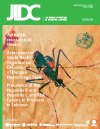Antibiotic resistance in Mexico: a brief overview of the current status and its causes
DOI:
https://doi.org/10.3855/jidc.427Keywords:
antibiotic resistance, developing countries, prescription practicesAbstract
As in many other developing countries, conditions that may foster antibiotic resistance in Mexico differ from developed countries, and so resistance prevalence. Fecal pollution and other traits of overcrowded, poor cities, might create ideal settings for selecting, exchanging and maintaining resistance traits. Medical abuse of antibiotics, along with low-quality drugs, are also present as in many developing countries. Self-prescription, a common yet unmeasured practice among Mexican population, may also contribute to increased resistance rates. Pneumococcal resistance towards penicillin and macrolides are the highest in Latin American countries, as is resistance of Salmonella and uropathogenic Escherichia coli towards ampicillin and sulfamethoxazole-trimethoprim; about one tenth of isolates of these gram-negative pathogens seem to produce extended-spectrum beta-lactamases (ESBL). High rates of multiple-drug resistant Mycobacterium tuberculosis are also found in Mexico, although there is no report of extensively drug-resistant strains. As to hospital-acquired pathogens, about a third of E. coli and Klebsiella isolates are ESBL-producers, and half of Staphylococcus aureus isolates are resistant to oxacillin (MRSA). Around 40% Pseudomonas aeruginosa isolates are resistant to ceftazidime, imipenem or levofloxacin. Although community-acquired MRSA, vancomycin-resistant enterococci, and other resistance problems found in developed countries, are not as common in Mexico, local issues are no small concern, and are disturbingly moving towards outpatients.Downloads
Published
2010-01-04
How to Cite
1.
Amabile-Cuevas C (2010) Antibiotic resistance in Mexico: a brief overview of the current status and its causes. J Infect Dev Ctries 4:126–131. doi: 10.3855/jidc.427
Issue
Section
Regional Reviews
License
Authors who publish with this journal agree to the following terms:
- Authors retain copyright and grant the journal right of first publication with the work simultaneously licensed under a Creative Commons Attribution License that allows others to share the work with an acknowledgement of the work's authorship and initial publication in this journal.
- Authors are able to enter into separate, additional contractual arrangements for the non-exclusive distribution of the journal's published version of the work (e.g., post it to an institutional repository or publish it in a book), with an acknowledgement of its initial publication in this journal.
- Authors are permitted and encouraged to post their work online (e.g., in institutional repositories or on their website) prior to and during the submission process, as it can lead to productive exchanges, as well as earlier and greater citation of published work (See The Effect of Open Access).








